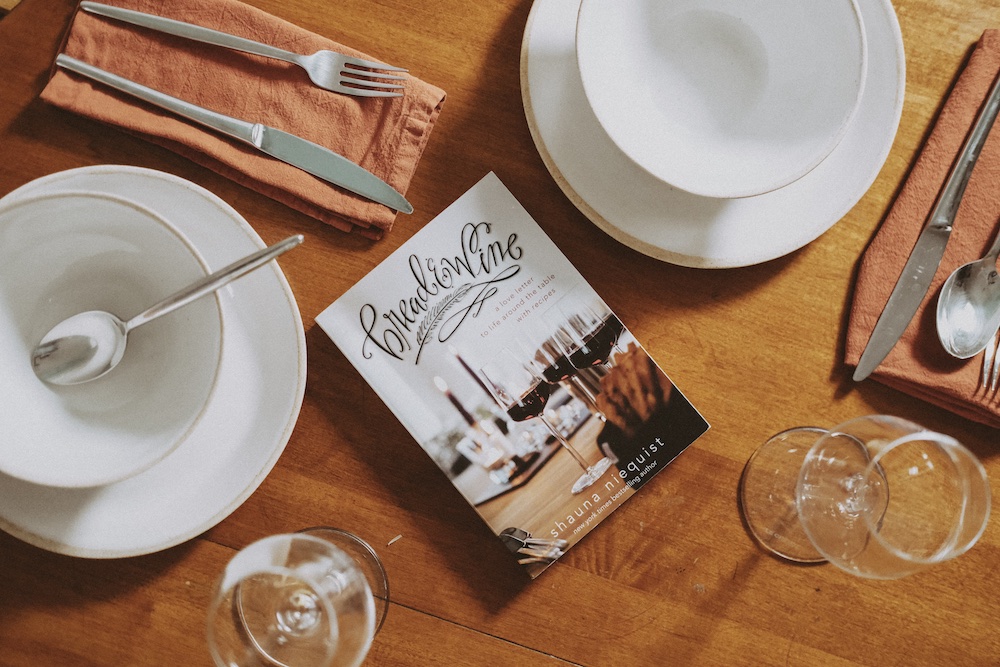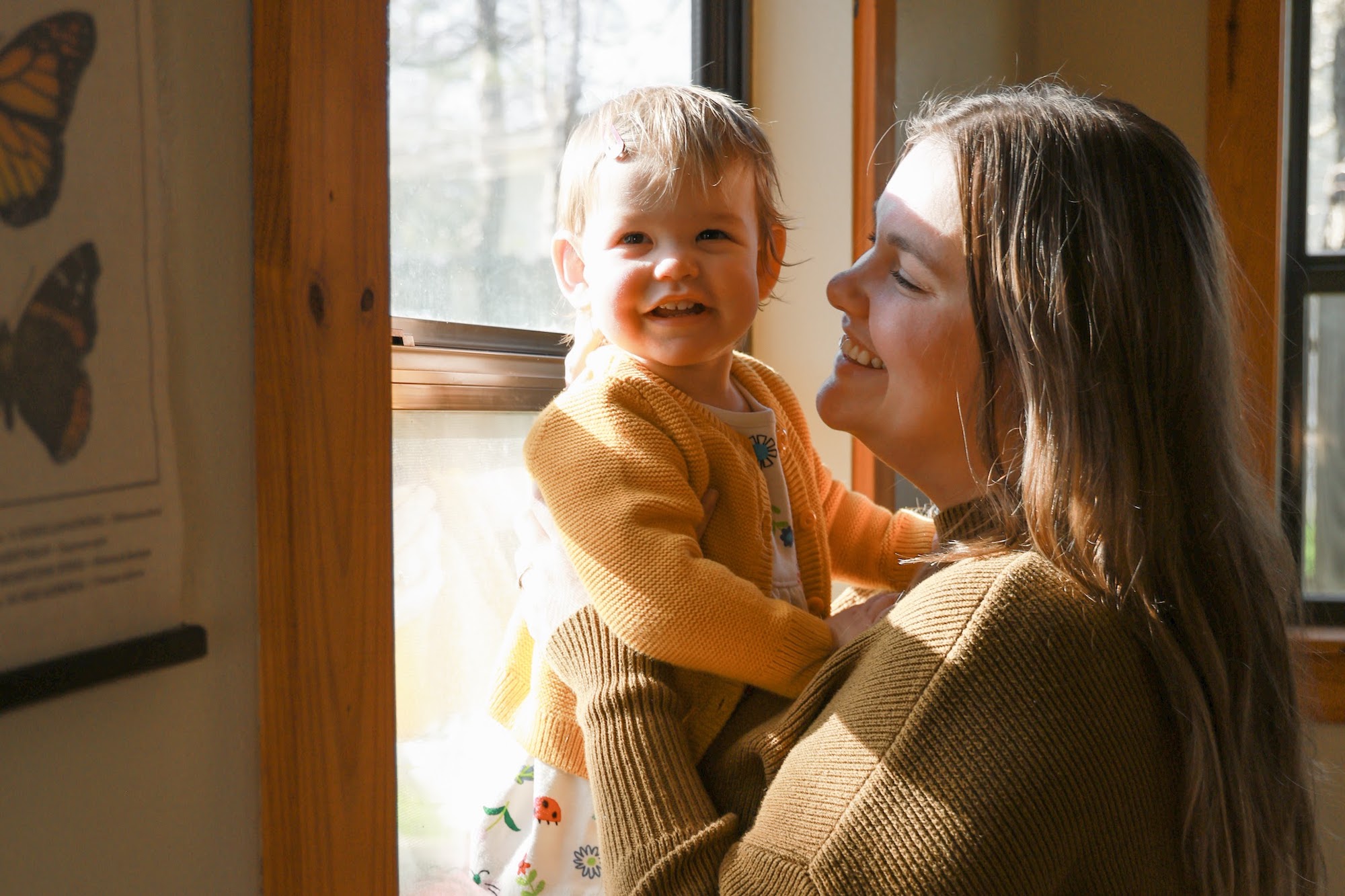From Shauna Niequist, author of Cold Tangerines, Present Over Perfect, and recent release I Guess I Haven’t Learned That Yet, comes Bread & Wine, a collection of delicious essays about life around the table. While food is the guiding theme of this book, the author writes about her life, family, struggles, and wins. Shauna Niequist is one of my favorite authors. Niequist is funny and relatable, her writing style is clear yet distinct. I love the way that she tackles difficult topics with generosity and gentleness. There is something remarkable about the way she writes. It’s as if she perfectly marries poetry and journalism. Her work is direct and clear, while somehow also sparkly and magical. She takes ordinary moments from her life and paints them so vividly, you feel like you can taste them.
Bread & Wine is full of funny and heartfelt stories about the author’s profound affection for food and hospitality. She writes about the war between her love of food and her discomfort with the size of her body, as well as how life around the table connects her to others and to God. Niequist nestles recipes among the essays, favorites she has collected and perfected over the years (I must confess, I didn’t attempt any of the recipes, but I want to!). I love the way that Niequist writes about the importance of gathering around the table. She describes why food matters this way,
“Food matters because it’s one of the things that forces us to live in this world—this tactile, physical, messy, and beautiful world—no matter how hard we try to escape into our minds and our ideals. Food is a reminder of our humanity, our fragility, our createdness.”

My Food Story
Reading Bread & Wine has inspired me to reflect on my own memories around food and the table.
I grew up in a home with a deep value for hospitality. My parents were ministers, generous ones, with their time and money and home. Creating a home that was warm and safe was a top priority to them, and though we moved to several houses over the course of my childhood, of different styles and sizes, the sense of comfort followed my parents to wherever their home was made in that season. My mom poured her body and soul into the food she made, determined that no one would ever go hungry in her home. I didn’t know it at the time, but there were seasons when the feasts she made were something near magic, considering the budget she had to work with. She could stretch and conjure and multiply. There was always enough.
Like many, the foods that I remember most clearly are holiday foods. When family gather together to take part in the same dishes at the same tables with the same people. Each Easter, my mom let us help her make the famous bunny cake, from a recipe torn out of a magazine some time around 1996, now treasured and worn and still used today. We made sugar cookies at my grandparents house on Christmas Eve, a few for Santa and many for us. Like families, some of our traditions are common and some are unique. My grandfather makes Thanksgiving stuffing with oysters and my uncle makes deviled eggs with jalapenos.
When my family moved overseas when I was in sixth grade, food became an important soure of comfort and stability. In a country where we chose daily to immerse ourselves in a culture that felt strange to us, the food from my mom’s kitchen was steady and familiar. Chicken spaghetti and homemade bread, colorful salads, fajitas and other Mexican favorites with guacamole and homemade tortillas, to name a few.
Dinner in my parents’ home often includes a special game of my dad’s invention, where each person draws a name and must confess their two favorite things about that person. This game has proven to be a source of connection and healing over the years, when those things seemed very far away.
There are some meals that stay with us forever. I ate minestrone the night that I packed my bags and left my home in east Africa, where I’d spent the last year living and working. The power was out, which wasn’t unusual, and I ate in the dark, in the same kitchen where I’d done an infinite amount of dishes, and learned to make coffee with a French press, and realized that maybe I loved that boy I left back in Texas.
I ate chicken tacos and drank Coca-Cola Life nearly every day when I worked at a flower shop in college. I learned a lot about life from the women I worked with there: about love and grief and sex. I spent many nights in college sitting on the back porch with my roomates, drinking red wine and talking, always talking, about dreams and hurts and hopes.

My husband was a baker in one of the many lives he’s lived, and when we first starting seeing one another, he brought loaves of bread to me at the library where I worked. On Wednesday evenings after selling at the farmers market, he would tap on the back door, interrupting my shelving and straightening, with a smile and a loaf of olive and walnut or a baguette in hand.
I remember all the food in the first few days of our marriage. We ate leftover biscuits the morning after our wedding, too distracted the night before to remember to put in the order for our fancy room service breakfast. I made pasta in the cabin where we honeymooned, singing a hymn while stirring tomato sauce and wondering how I could have possibly gotten so lucky. We ventured from the cabin one day to explore the small town nearby, where we bought a bottle of wine and farmers market cheese and bread for dinner, my favorite meal on any given day.
Now that I’m pregnant with my first baby, my relationship with food has changed significantly. There are foods I once loved that I now find repulsive. I crave pickles and peanut butter, and most of the time all I want to eat is fruit. I am more aware than I ever have been of the necessity of food, my deep responsibility to nourish not only myself but my daughter as well. Food is about so much more than fuel. It’s intimacy and connection and vulnerability. It’s childhood and memory and growth. Choosing to put thought and care into your meals, whether a fancy risotto or a grilled cheese sandwich, is a tremendous gift, even if it is only to youself. To invite someone into your home, to love someone with your table, to me is the most sacred of practices.
“We don’t come to the table to fight or to defend. We don’t come to prove or to conquer, to draw lines in the sand or to stir up trouble. We come to the table because our hunger brings us there. We come with a need, with fragility, with an admission of our humanity. The table is the great equalizer, the level playing field many of us have been looking everywhere for. The table is the place where the doing stops, the trying stops, the masks are removed, and we allow ourselves to be nourished, like children. We allow someone else to meet our need. In a world that prides people on not having needs, on going longer and faster, on going without, on powering through, the table is a place of safety and rest and humanity, where we are allowed to be as fragile as we feel.” -Shauna Niequist, Bread & Wine
Thank you for reading my thoughts on Bread & Wine by Shauna Niequist. Join my email newsletter for weekly updates on the blog.
Photos by Kara Buse.





